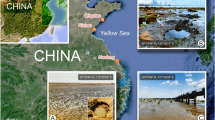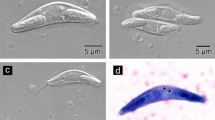Abstract
A flagellated predator of the chlorophyte algaDunaliella spp. was examined by light and electron microscopy. Although this predator had previously been identified as a species of the kinetoplastid genusBodo, the present study revealed the flagellate to be indistinguishable fromColpodella pugnax, the type-species for its genus. The flagellate lacks a kinetoplast, a microtubule supported cytopharynx and paraxial rods in the flagella — characters universally found in kinetoplastid flagellates. The cell has mitochondria with vesicular cristae. Multiple membranes surround the cell and are underlain by longitudinal microtubules not originating from the flagellar region. Most notably, the flagellate has micropores and an apical complex including a conoid, sacculate rhoptries and, apparently, a polar ring. This study hs confirmed thatColpodella is the genus with free-living species most closely related to the apicomplexan parasites (i.e. the “Euapicomplexa” andPerkinsus). No unambiguous synapomorphy supports an “apicomplexan parasites” clade: Inclusion ofColpodella is necessary to secure the Apicomplexa as a monophyletic (=holophyletic) taxon. A new family, the Colpodellidae, is erected for this genus.
Colpodella turpis, a previously undescribed species that also consumesDunaliella spp., was isolated from the same samples asC. pugnax. A diagnosis for this species is presented together with a brief review of the genus, in which we recognise seven species. The generic namesAlphamonas Aléxéieff,Nephromonas Droop andDingensia Patterson & Zölffel are rendered into synonomy withColpodella.
Similar content being viewed by others
References
Aléxéieff, A. (1918) Sur un flagellé coprozoiteAlphamonas coprocola n. g., n. sp.Archives de Zoologie Expérimentale et Générale, 57, 1–11.
Aléxéieff, A. (1924) Notes sur quelques protistes coprocoles.Archiv für Protistenkunde, 50, 27–49.
Aléxéieff, A. (1929) Matériaux pour servir a l'etude des protistes coprozoites.Archives de Zoologie Expérimentale et Générale, 68, 609–698.
Azevedo, C. (1989) Fine structure ofPerkinsus atlanticus n. sp. (Apicomplexa, Perkinsea) parasite of the clamRuditapes decussatus from Portugal.Journal of Parasitology, 75, 627–635.
Brooker, B.E. (1971) Fine structure ofBodo saltans andBodo caudatus (Zoomastigophora: Protozoa) and their affinities with the trypanosomatidae.Bulletin of the British Museum of Natural History [Zoology], 22, 89–102.
Brugerolle, G. (1985) Des trichocystes chez les bodonides un car actère phylogénétique supplémentaire entre Kinetoplastida et Euglenida.Protistologica, 21, 339–348.
Brugerolle, G., Lom, J., Nohynkova, E. & Joyon, L. (1979) Comparaison et évolution des structures cellulaires chez plusiers espèces de bodonidés et cryptobiidés appartenant aux genresBodo, Cryptobia etTrypanoplasma (Kinetoplastida: Mastigophora).Protistologica, 15, 197–221.
Brugerolle, G. & Mignot, J-.P. (1979) Observations sur le cycle. l'ultrastructure et la position systématique deSpiromonas perforans (Bodo perforans Hollande 1938), flagellé parasite deChilomonas paramecium: Ses relations avec les dinoflagellés et sporozoaires.Protistologica, 15, 183–196.
Cienkowski, L. (1865) Beiträge zur Kenntniss der Monaden.Archiv für Mikroskopische Anatomie, 1, 203–232.
Corliss, J.O. (1979) The impact of electron microscopy on ciliate systematics.American Zoologist, 19, 573–557.
Dangeard, P.-A. (1900) L'organisation et le développement duColpodella pugnax.Le Botaniste, 7, 5–29.
Droop, M.R. (1953) On the eeology of flagellates from some brackish and fresh water rockpools of Finland.Acta Botanica Fennica, 51, 1–52.
Dujardin, F. (1841)Histoire naturelle des zoophytes infusoires. Paris: Roret, 684 pp.
Foissner, W. & Foissner, I. (1984) First record of an ectoparasitic flagellate on ciliates: an ultrastructural investigation of the morphology ofSpiromonas gonderi nov. spec. (Zoomastigophora, Spiromonadidae) invading the pellicle of ciliates of the genusColpoda (Ciliophora, Colpodidae).Protistologica, 20, 635–648.
Gonder, R. (1910) Ein Parasit vonColpoda cucullus.Archiv für Protistenkunde, 18, 275–277.
Hänel, K. (1979) Systematik und Ökologie der farblosen Flagellaten des Abwassers.Archiv für Protistenkunde, 121, 73–137.
Hollande, A. (1938)Bodo perforans n. sp., flagellé noveau parasite externe duChilomonas paramecium Ehrenb.Archives de Zoologie Expérimentale et Générale, 7, 75–81.
Kent, W.S. (1880–1882)A manual of the Infusoria. London: Bogue, 3 vols, 913 pp.
Klebs, G. 1892. Flagellatenstudien.Zeitschrift für Wissenschaftliche Zoologie, 55, 265–445.
Krylov, M.V. & Mylnikov, A.P. (1986) [New taxa in the Phylum Sporozoa, Spiromonadomorphina subcl. n., Spiromonadida ordo n.]Parazitologiya, 20, 425–430. (In Russian).
Kühn, A. (1915) Über Bau, Teilung und Encystierung vonBodo edax Klebs.Archiv für Protistenkunde, 35, 213–255.
Larsen, J. & Patterson, D.J. (1990) Some flagellates (Protista) from tropical marine sediments.Journal of Natural History, 24, 801–937.
Levine, N.D. (1987) Phylum II. Apicomplexa. In: Lee, J.J., Hutner, S.H. & Bovee, E.C. (Eds).An illustrated guide to the protozoa. Lawrence, Kansas: Society of Protozoologists, pp. 322–357.
Levine, N.D., Corliss, J.O., Cox, F.E.G., Deroux, G., Grain, J., Honigberg, B.M., Leedale, G.F., Loeblich, A.R.III, Lom, J., Lynn, D., Merinfeld, E.G., Page, F.C., Poljansky, G., Sprague, V., Vavra, J. & Wallace, F.G. (1980) A newly revised classification of the protozoa.Journal of Protozoology, 27, 37–58.
Macdonald, C.M. & Darbyshire, J.F. (1977) The morphology of a soil flagellate,Spiromonas angusta (Duj.) Aléxéieff (Mastigophorea: Protozoa)Protistologica, 13, 441–450.
Mylnikov, A.P. (1983) [Feeding of predatory zooflagellates].Information Bulletin Biologiya Vnutrennikh Vod, 62, 16–19. (In Russian).
Mylnikov, A.P. (1986) Ultrastructure of a colourless flagellate,Phyllomitus apiculatus Skuja 1948 (Kinetoplastida).Archiv für Protistenkunde, 132, 1–10.
Mylnikov, A.P. (1988a) [The fine structure of a carnivorous flagellateBodo sp.]Tsitologiya 30, 240–244. (In Russian).
Mylnikov, A.P. (1988b) [The biology and life cycle ofBodo edax Klebs].Information Bulletin Biologiya Vnutrennikh Vod. 77, 28–31. (In Russian).
Mylnikov, A.P. (1991) [Ultrastructure and biology of certain representatives of the order Spiromonadida (Protozoa)].Zoologicheskiy Zhurnal, 7, 5–15. (In Russian).
Palmer, J.D. (1992) Green ancestry of malarial parasites?Current Biology, 2, 318–320.
Patterson, D.J. (1982) Photomicrography using a dedicated electronic flash.Microscopy, 34, 437–442.
Patterson, D.J. (1993) The current status of the free living heterotrophic flagellates.Journal of Eukaryotic Microbiology, 40, 606–609.
Patterson, D.J. (1994) Protozoa: evolution and systematics. In: Hausmann, K. & Hülsmann, N. (Eds).Progress in Protozoology. Stuttgart: Gustav Fischer, pp. 1–14.
Patterson, D.J. & Brugerolle, G. (1988) The ultrastructural identity ofStephanopogon apogon and the relatedness of the genus to other kinds of protists.European Journal of Protistology, 23, 279–290.
Patterson, D.J. & Sogin, M.L. (1992) Eukaryote origins and protistan diversity. In: Hartman, H. & Matsuno, K. (Eds)The origin and evolution of the cell. New York: World Scientific Publishers, pp. 13–46.
Patterson, D.J. & Larsen, J. (1991) General introduction. In: Patterson, D.J. & Larsen, J. (Eds)The biology of free-living heterotrophic flagellates. Oxford: Clarendon Press, pp. 1–6.
Patterson, D.J. & Zölffel, M. (1991) Heterotrophic flagellates of uncertain taxonomic position. In: Patterson, D.J. & Larsen, J. (Eds).The biology of free-living heterotrophic flagellates. Oxford: Clarendon Press, pp. 427–475.
Perkins, F.O. (1976) Zoospores of the oyster pathogen.Dermocystidum marinum. I. Fine structure of the conoid and other sporozoan-likeorganelles.Journal of Parasitology, 62, 959–974.
Post, F.J., Borowitzka, L.J., Borowitzka, M.A., Mackay, B. & Moulton, T. (1983) The protozoa of a Western Australian hypersaline lagoon.Hydrobiologia, 105, 95–113.
Rowley, J.C.III. & Moran, D.T. (1975) A simple procedure for mounting wrinkle free sections on formvar coated slot grids.Ultramicroscopy, 1, 151–144.
Stein, F.R. (1878)Der Organismus der Infusionthiere. III. Der Organismus der Flagellaten I. Engelmann, 154 pp.
Vickerman, K. (1991) Organization of the bodonid flagellates. In: Patterson, D.J. & Larsen, J. (Eds).The biology of free-living heterotrophic flagellates. Oxford: Clarendon Press, pp. 159–176.
Wilson, R.J.M., Williamson, D.H. & Preiser, P. (1994) Malaria and other apicomplexans: the plant connection.Infectious Agents and Disease, 3, 29–37.
Zhukov, B.F (1991) The diversity of bodonids. In: Patterson, D.J. & Larsen, J. (Eds).The biology of free-living heterotrophic flagellates. Oxford: Clarendon Press, pp. 177–184.
Author information
Authors and Affiliations
Rights and permissions
About this article
Cite this article
Simpson, A.G.B., Patterson, D.J. Ultrastructure and identification of the predatory flagellateColpodella pugnax Cienkowski (Apicomplexa) with a description ofColpodella turpis n. sp. and a review of the genus. Syst Parasitol 33, 187–198 (1996). https://doi.org/10.1007/BF01531200
Accepted:
Issue Date:
DOI: https://doi.org/10.1007/BF01531200




